History of Aigeira – Overview
At the Municipal Unity of Aigeira, near Palaiokastro hill at an altitude of approx. 300m, is the citadel of the Mycenaean city called Hyperesia (aka Iperisia, meaning Service).
Ancient Aigeira (Hyperesia) was one of the most important cities of Achaea and of the Achaean League. Its inhabitants participated in the Trojan War (Homer Iliad , Il . 573-577).
Nearby are the ruins of classical – Hellenistic – Roman Aigeira, where the theater is one of the most important monuments. The ancient city of Aigeira must have prospered until the 4th AD century. It is argued that it was destroyed by a strong tidal wave, but is more likely to have been destroyed by a powerful earthquake. The theater of Ancient Aigeira was excavated in the early 20th century by Austrian archaeologists of the Austrian Archaeological Institute. It was originally built in the 3rd century BC and rebuilt by the Romans in the 2nd century AD.
Ancient Aigeira a.k.a Hyperisia
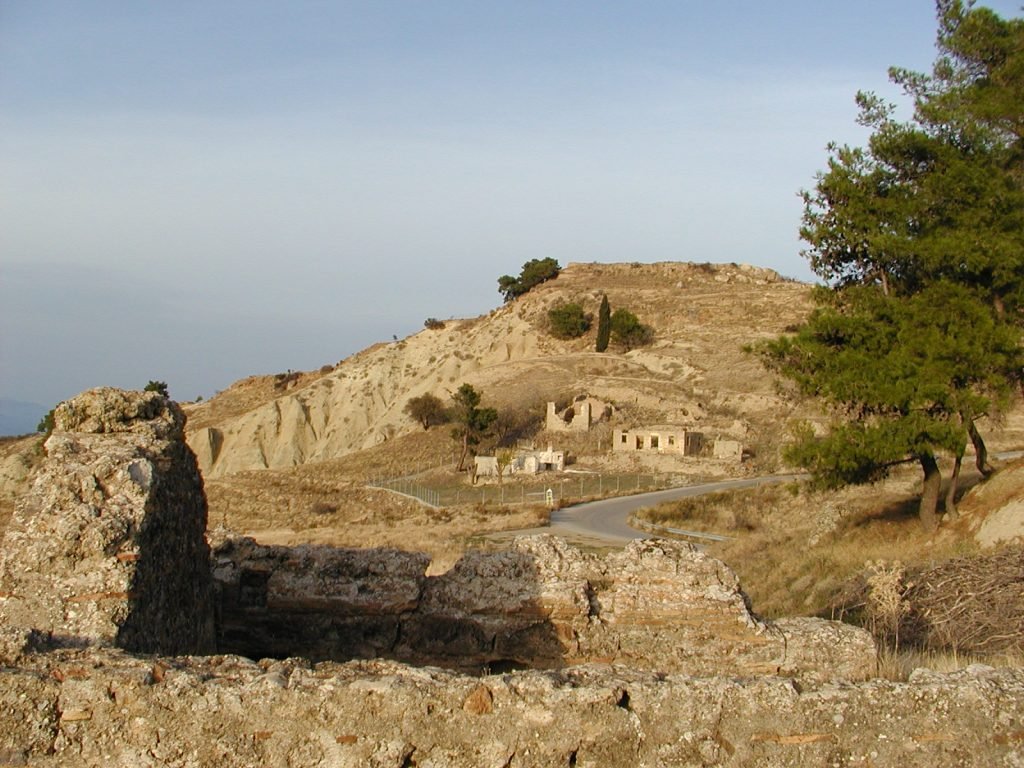
Historians and geographers of antiquity like Pausanias and Strabo wrote about Ancient Aigeira, which existed before the time of Homer, who have traced it between Sikyon and Aigio.

Polybius referring to the position of Aigeira writes “ή δέ τών Αιγειρατών πόλις έκτισται μεταξύ τής Αίγιέων και Σικυωνίων πόλεως, κείται δέ επί λόφων ερυμνών και δυσβάτων, νεύει δε προς τον Παρνασσόν” (…the people of Aigeira city is built between (those) of Aegion and Sikyon cities, it is situated on fortified and inaccessible hills, sees to Parnassus).
According to the Austrian archaeologist Wilhelm Alzinger the first people settled-in during the third millennium BC (Early Helladic period.) Their presence is revealed by pottery fragments found in excavations in the lower layers.

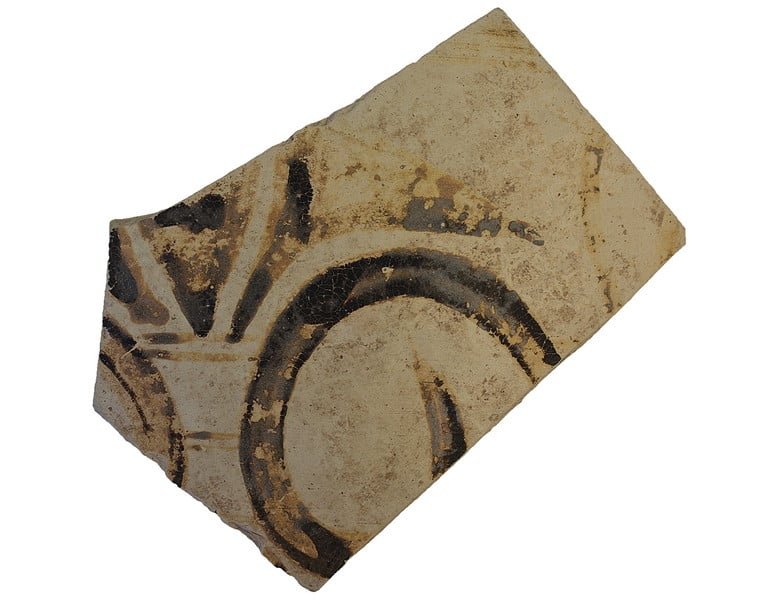
The potsherds are an irrefutable source of evidence for the origin and continuous presence of Aigeira even from the time of the Pelasgians (the forerunners of ancient Greeks). Around 2089BC for example king Aigialeos -of Pelasgian origin- founded the kingdom “Aigialos” based in Sikyona and bounds along the Gulf of Corinth to Elis. The residents were called Aegialian Pelasgians.
Later, and before 1400 AD, in the regions between Sikyon and Ilida were founded the small independent kingdoms (probably descendants of Aigialeos) of Hyperisia (Aigeira), Aegae (or Aigai) and Aigio.
During the prehistoric period the Argonauts, Apollonius of Rhodes (author of Argonautica, popularly known as the story of “Jason and the Golden Fleece”) cites as the crew of the legendary “Argo” Asterion and Amphion, sons Hyperasiou from Pellene.
In the Homeric period it was known as Hyperisia (greek: Υπηρεσία ή Υπερησίη) and this name is mentioned by Homer (Iliad B’ 574) in the list of 100 Mycenaean ships that took part in the Trojan War with Aiges, Egio, Gonousa, Pellini and Eliki. Also we learn that these cities belonged to the sphere of influence of Mycenae and the warriors were called “Aigialos’ warriors”. For this reason in the starting line-up of the troops
Hyperisians, aligned themselves with the Mycenaean troops in the center of the army.
The Hyperisi name, or according to Pausanias Hyperisia, was maintained in Ancient Aigeira for many centuries and according to archaeologist Otto Walter until the 23rd Olympiad in 688 BC
As mentioned by Pausanias (Pausanias, Description of Greece), Hyperisia Aigeira got its name when the Ionians lived there and were raided by the Sicyons. Then the inhabitants in order to defend themselves effectively because they were few, they gathered all the goats (greek: aiges) in the area and after they lit torches that were placed on horns they waged them against Sikyon, who feared and fled. So because
Hyperisia was saved from the goats (αίγες) the people changed the name of the city to Aigeira.
” Οί Υπερησιείς δέ τή τε πόλει τό όνομα τό νύν μετέθεντο υπό τών αιγών ” (The Hyperesians the city name thy changed after the goats)
Pausanias, Description of Greece, Achaia, Chapter 26.
Its inhabitants for their victory, built the temple of Artemis Agrotera because they believed that the trick (the goats) against the invaders was inspired by Artemis.
But there are those who argue that the ancient Aigeira got this name from aígeiros (a species of poplar tree which was abundant in the region in ancient times), or by a nobleman from Patras named Aigeiro, who after capturing it, he reigned therein and gave his name.
Ancient Aigeira spent periods of great prosperity and well-being. Because of the advantageous position it held in the eastern part of Aigialeia, north of Evrostina mountain, was visible both from neighboring cities of Corinth and the opposite, Central Greece towns of the Aetolians. Thus sometimes the city suffered hostile attacks, best known amongst is the one of the Aetolians in 220 or 219 BC and Sikionion.

In Ancient Aigeira, according to the descriptions of Pausanias, there was a statue of Zeus (made of marble from Mount Penteli of Attica), a statue of Athena, temple of goddess Iphigenia (whose worship was later joined with Artemis), also statues of ‘Asclepius, and sanctuary to Apollo. Also, there were sanctuaries of Serapis and Isis, which attest the trade relations Aigeira with the ancient Egyptians (as with the Ancient Aigio.)
Ancient Aigeira in Achaean League (greek: Αχαϊκή Συμπολιτεία)
After the end of the Trojan War (~1184 BC) until the Peloponnesian War (431–404 BC), the Achaia cities remained neutral and flourished culturally and economically. This prosperity, the advanced culture, the common traditions and religion led Achaean cities to shake off the status of the kingdom and unite as the Achaean League (greek: Αχαϊκή Συμπολιτεία). The constitution and democracy developed then was clearly superior to the Athenian Democracy. In much so that the Achaean League ambassadors, were invited from all other Greek cities as the only reputable and honest intermediaries between them. Ancient Aigeira was amongst those cities at the forefront of the federation.
Until the establishment of the Second Achaean League before 281 BC ancient Aigeira was reinforced by the abandonment of the ancient city of Aigai, the integration of its population and sharing of territories (with Aigion) and is at its heyday.
The city was still flourishing until the 4th AD century and this comes as a conclusion from a decree of the Roman emperor Diocletian that set the prices of various foods which were bought by the Roman soldiers to avoid exploitation by traders of that era. The decree was written in marble found in excavations of ancient Aigeira and believed to have been written in 301 AD (The plate is usually located in the Market Center, mainly cities were Roman Guard) and were written in the Greek language.

Photo: Epigraphic Museum of Athens
Decline of Ancient Aigeira
Until the 8th AD century archaeologists argue that Ancient Aigeira was abandoned definitively. They speculated that was either destroyed by an earthquake, either because of the position was too exposed to barbaric invasions of the 5th to 7th AD century, or because of the deadly plague, the inhabitants moved to the south the mountains of peripheral settlements of Aegae, Monastiri, Seliana (Ancient Phelloe). Since then, and until the establishment of the modern coastal town of Aigeira (1927), the name had been preserved in the memory of the inhabitants. Straight after the revolution of 1821 the Municipality of Aigeira is established (1834 to 1912) based in Chrysanthio, which included the settlements of Aegae, Ampelokipi, and Chrysanthio.
Olympic Winners of Aigeira
References of two Olympic winners from Aigeira, Cratinus (Kratinos) and Icarius (Ikaros) can be found in Pausanias and Eusebius works.
[6.3] Cratinus of Aegeira in Achaia was the most handsome man of his time and the most skilful wrestler, and when he won the wrestling-match for boys the Eleans allowed him to set up a statue of his trainer as well. The statue was made by Cantharus of Sicyon, whose father was Alexis, while his teacher was Eutychides. Pausanias. Pausanias Description of Greece with an English Translation by W.H.S. Jones, Litt.D., and H.A. Ormerod, M.A., in 4 Volumes. Cambridge, MA, Harvard University Press; London, William Heinemann Ltd. 1918.
Eusebius of Caesarea, in his work “Chronicle” names Icarius of Hyperesia (Aegeira) to have won the race of 1 stadium in the 23rd Olympiad, 688 BC. (Pausanias refers his name as Ikaros).
23rd [688 B.C.] – Icarius of Hyperesia, stadion race.
Eusebius: Chronicle, page 193
Archaeological Surveys – Excavations
The first excavations at the ancient Aigeira site began in 1916 by the Austrian Archaeological Institute, which is doing so until today. The archaeological findings to date cover a period from 3000 BC until imperial times of Rome and almost to the 4th century AD. From the earliest days when work commenced, the research carried by Otto Walter was crowned by great success.

On August 31, 1916 a marble statue head of Zeus was discovered. According to Pausanias, the statue was the work of the famous sculptor Euclid from Athens, and its height should exceed three meters.
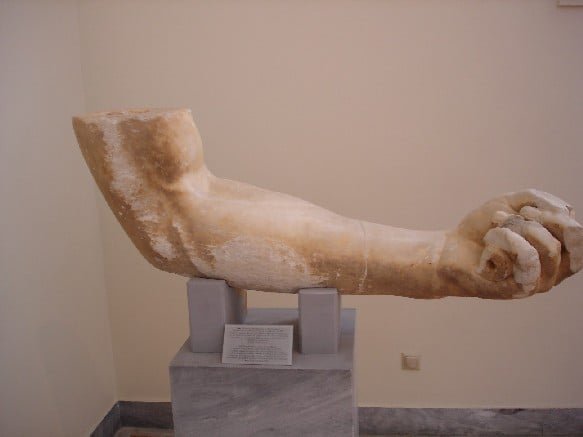
Subsequent research revealed the left arm of the same statue and a finger of the right hand.
The second stunning discovery of Walter was the hollow “koilon” of the theater of Ancient Aigeira. According to Wilhem Alzinger, who lead the excavations from 1972 onwards, the theater was built in the 5th to 4th century BC. The proscenium (front part of the stage) of the theater was decorated with pilasters.
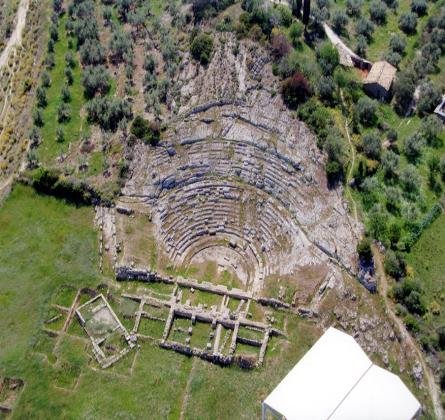
Also preserved is the drainage system of the orchestra and the north wall of the scene with a central gate. Most of these elements of the theater was destroyed in the 2nd century AD when the scene was converted. This conversion created a three-storey stage where
little evidence remains of its architectural decoration. The facade was divided into three floors with a protective roof. The lower floor was Doric, the middle Ionic and Corinthian at the top. The construction of the three-storey stage dates back to the years of Hadrian, 117-138 AD.
At the site of the excavations have also been discovered part of city walls, a kiln for pottery, pottery fragments from 3000 BC, marble slabs on which is written the decree of the Roman emperor Diocletian, many inscriptions and names.
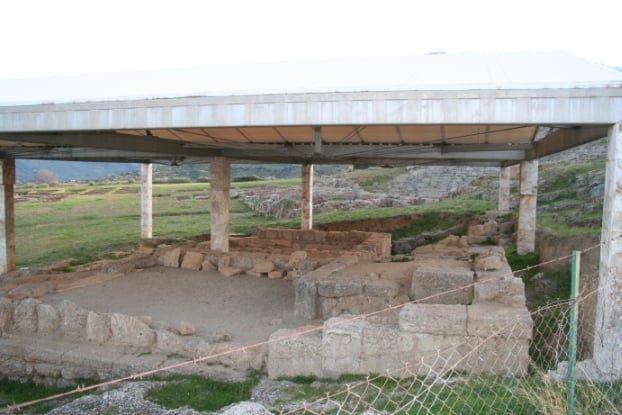
During the 1972 excavations in the northern part of the theater was uncovered, as believes Alzinger, part of the temple of Zeus. The floor is paved with a magnificent mosaic of river pebbles and decorated with various performances, such as vultures, beetles, an eagle attacking snake and two vases.
Watch Towers of Ancient Aigeira
Ancient Aigeira having a dominant position in the region maintained its strategic advantage with defensive military outposts “watch towers” or “beacons” in important locations. At the rock of Evrostini, just above the Palaiokastro is a square carved boulder (size 1×1 m. And 70cm deep) is probably the main outpost facing as far as Aigio (~25km away).
Alongside the fortification sites, relics of which still exist, “Tower” Aegae, Ag. Thodoroi Monastiri, Alonia Seliana and “Frankish” Sinevro it is believed that composed the remaining network of protection and timely alerting of the mountainous regional settlements of the ancient metropolis.
Coins of Ancient Aigeira
From the list of currencies of the monetary collection of Copenhagen it seems that Aigeira at around 330 BC issued bronze coins with Athena at the front face and a goat within olive wreath at the reverse. Other currency that was issued were coins with veiled woman’s head and on the front side is the inscription “Aigiraton” and behind, a goat with a wreath. Also in 193-221 AD with the bust of Plaftillas, wife of the Roman Emperor Caracalla.

Coins of Ancient Aigeira issued during Achaean League
Ancient Theatre of Aigeira

One of the most important monuments of the city, although not mentioned by Pausanias in the 2nd century. AD is the ancient theater. It has horseshoe-shaped hollow overlooking the Corinthian Gulf and is located at an altitude of 350 m. from the sea.
Its construction dates from the first half of the 3rd century BC, around 280-250 BC, when Achaean League was established (Achaean Sympoliteia) and achaean cities reorganized. The hollow was curved on the natural conglomerate sedimentary rock, where there was not, the ground was properly formed and stone seats were placed.
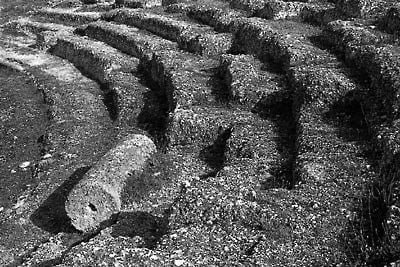
The stage (orchestra) was also curved for the most part in the natural rock, on the curbs of which a groove was built for the drainage of rainwater. The stage building of the Hellenistic period was two-storied. A frieze divides the hollow into two parts and the total capacity amounts to 3000 spectators, while its length reaches 30.70 meters.
Ancient Theater and Acropolis of Aigeira – Video
Latest archaeological developments
During the investigation of trial trenches in the site of Marmara, Aigeira, the remains of a sanctuary were traced in the place where the opening of the eastern part of the Akrata tunnel 13A had been planned. The latter was to be opened to the west of the archaeological site of Aigeira, in an amphitheatrical area with steep inclination towards the western bank of the Krios river.

During the investigation of trial trenches in the site of Marmara, Aigeira, the remains of a sanctuary were traced in the place where the opening of the eastern part of the Akrata tunnel 13A had been planned. The latter was to be opened to the west of the archaeological site of Aigeira, in an amphitheatrical area with steep inclination towards the western bank of the Krios river.
The sanctuary is built in two terraces, since the site has a very steep inclination; it is estimated that its area covered more than 2000 sq.m. The first building found was the so called naiskos, which probably had a cultic character. Its ground plan is rectangular, with a prodomos and cella, while its orientation follows the north-south axis. The walls are built with large rectangular and polygonal stones of the local conglomerate stone. The building blocks are roughly worked, with the exception of their face, which is finely cut.
In the middle of the northern narrow wall two stone bases were found supporting the marble statues of two children. The feet of the statues are preserved up to the ankles, their bases having been joined to the pedestals with molten lead. A large number of small finds was found: terracotta vessels and figurines and more than 70 bronze objects (omphalos bowls, handles, figurines, jewelry, a small tripod, a small plaque with two female heads in relief, door implements, pins and a mirror). The finds date mostly to the 4th and 3rd cents. B.C., although earlier finds are not missing either.

The bronze mirror bears an inscription with the name of the goddess Eileithyia, while another object, probably a key, bears an inscription with the name of Demeter. Consequently the sanctuary is dedicated to Demeter and probably to Kore also, while Eileithyia, the goddess of labour, was adored there too.
The cult of Eleithyia was generally popular in the Peloponnese (note 2). According to Pausanias, the goddess had been worshiped in the cities of Aegialeia, Aeghion, Voura and Pellene (note 3).
In the same terrace, on the southwestern edge of the sanctuary and 17 m. southern of the naiskos’ entrance, a large ceremonial pyre was revealed. Αn irregular four-sided projection has been constructed on the rock, in the center of the pyre, measuring 2,40×4,10m. It closely resembles an altar in the Thesmophorion of Pella, which is also of an irregular four-sided form and made of successive layers of stone chips and clay (note 4).
This simple construction could be classified typologically as an ash altar. Many broken animal bones and finds, some completely burnt, came from the pyre; they included mostly female figurines, jewelry – mainly of silver – and broken pots, dating from the Archaic to early Hellenistic times.
On the lower terrace to the east, small structures with rectangular or trapezoidal ground plans were excavated. They were carelessly built and in their interior built benches were found. Those structures were auxiliary buildings of the sanctuary and they must have been used for common ceremonial meals.
The excavation of the sanctuary brought to light a large number of clay figurines mostly female. The earlier of these are handmade and date to the late 7th-6th cent. B.C., while in the 6th and 5th centuries the type of kore bearing a polos and holding a bird in front of the chest with one hand and fruit or wreath with the other is dominant. The same figure is also shown seated, usually holding a bird on the chest.
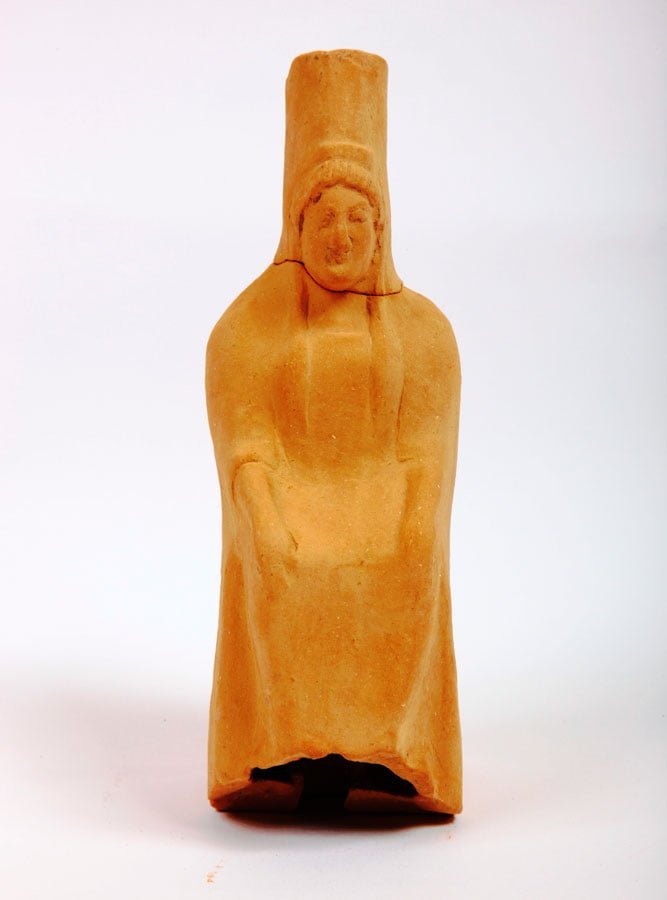
Among the bronze figurines are two winged male figures, two bovines, a deer and a rooster.
Much bronze jewelry was found, but also silver, such as an elaborate bracelet in the form of a snake, with a gilded head and tail, as well as earrings, pins, fibulae and many signet or simple rings.

The sanctuary at Marmara is not mentioned by ancient writers. When Pausanias visited Achaea during Roman times, the sanctuary had already been abandoned, according to the excavation evidence. Cultic activity in the area seems to have begun in the 7th cent. B.C., while the site had been occupied since the second half of the 8th cent. B.C.
The architectural remains are dated to the 5th and 4th centuries B.C. and the sanctuary must have been abandoned by the 3rd century B.C. The stepped layout of the sanctuary brings to mind the sanctuary of Demeter and Kore in Corinth (note 5). Τhe sanctuary at Marmara probably belonged to the territory of Aigae, an Achaean city whose dominion must have extended to the west of the river Krios (note 6).
Videos
British School at Athens
Jeremy Rutter: Ceramic surprises from LH IIIC Aigeira
Amphitheater of Ancient Aigeira
Three Hellenistic ‘Naiskoi’ in the Theater Area at Aigeira: Architecture in an Urban Context from ASCSA.
Presented by: Alexandra Tanner (University of Zurich)